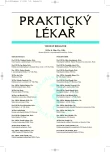Constipation and general practice – myths and facts
Authors:
Martínek Jan
Authors‘ workplace:
Primář: MUDr. Vladimír Nosek
; Gastroenterologické oddělení, Nemocnice Jablonec nad Nisou
Published in:
Prakt. Lék. 2008; 88(6): 328-336
Category:
Various Specialization
Overview
Constipation is a frequent symptom affecting approximately 20 % of the population. Secondary constipation is caused by a known disease (for example colorectal carcinoma). Primary constipation can be divided into two groups: colon inertia and outlet obstruction. Functional constipation means there is no organic or laboratory abnormality causing the constipation. Patients with colon inertia have prolonged transit time. Patients with outlet obstruction usually suffer from complicated defecation. If outlet obstruction is caused by a paradoxical contraction of the puborectalis muscle and of the external sphincter, the patients are classified as having anismus. Patients with anatomical obstruction of the anus (e.g. rectocele) are classified as having obstructive defecating syndrome (ODS). Physiotherapy is used for the management of patients with anismus while obstructive defecation syndrome is usually treated surgically. Often recommended measures (fluids, fiber) have only limited significance. Laxatives are often the only means of how to help people with severe constipation. No study has demonstrated any possible harmful effects of laxatives (dependence, tolerance, worsening of constipation, etc.), even though those myths are wide-spread. These drugs are very effective and safe, even when administered for a long period of time. Therefore, it does not make sense to discourage patients from such treatment if it helps. Hyperosmolar substances are also used as laxatives. In patients with constipation, the following examinations are frequently used: colonoscopy, transit time, defecography and anorectal manometry.
Key words:
constipation, colon inertia, anismus, laxatives, biofeedback.
Sources
1. Baker, J.T., Harvey, R.F. Bowel habit in thyreotoxicosis and hypothyroidism. Br. Med. J. 1971, 1, p. 322-323.
2. Miller-Lissner, S.A., Kamm, M.A., Scarpignato, C., Wald, A. Myths and misconceptions about chronic constipation. Am. J. Gastroenterol. 2005, 100, p. 232-242.
3. Waldron, D., Bowes, K.L., Kingma, Y.J. et al. Colonic and anorectal motility in zoune women with severe idiopathic constipation. Gastroenterology, 1988, 95, p. 1388-1394.
4. Klauser, A.G., Peyerl, C., Schindlbeck, N.E. et al. Nutrition and physical activity in chronic constipation. Eur. J. Gastroenterol. Hepatol. 1992, 4, p. 227-233.
5. Parisi, G.C., Zilli, M., Miani, M.P. et al. High-fiber diet supplementation in patients with irritable bowel syndrome: a multicenter, randomized, open trial comparison between wheat bran diet and partially hydrolyzed guar gum. Dig. Dis. Sci. 2002, 47, p. 1697-1704.
6. Towers, A.L., Burgio, K.L., Locher, J.L. et al. Constipation in the elderly: influence of dietary, psychological, and physiological factors. J. Am. Geriatr. Soc. 1994, 42, p. 701-706.
7. Goebos, K. Laxatives and intestinal epithelial cells: a morphological study of epithelial cell damage and proliferation. Verh. K. Acad. Geneeskd. Belg. 1995, 57, p. 51-74.
8. Ghadially, F.N., Walley, V.M. Melanoses of the gastrointestinal tract. Histopathology, 1994, 25, p. 197-207.
9. Tzavella, K., Schenkirsch, G., Riepl, R.L. et al. Effects of long-term treatment with anthranoids and sodium picosulphate on the contens of vasoactive intestinal polypeptide, somatostatin and substance P in the rat colon. Eur. J. Gastroenterol. Hepatol. 1995, 7, p. 13-20.
10. Bengtsson, M., Ohlsson, B. Retrospective study of long-term treatment with sodium picosulfate. Eur. J. Gastroenterol. Hepatol. 2004, 16, p. 433-434.
11. Ryan, F., Anobile, T., Scutt, D. et al. Effects of oral sodium picosulphate Picolax on urea and electrolytes. Nurs. Stand. 2005, 19, p. 41-45.
12. Wiesel, P.H., Dorta, G., Cuypers, P. et al. Patient satisfaction after biofeedback for constipation and pelvic floor dyssynergia. Swiss. Med. Wkly. 2001, 131, p. 152-156.
13. Redmond, J.M., Smith, G.W., Barofsky, I. et al. Physiological tests to predict long-term outcome of total abdominal colectomy for intractable constipation. Am. J. Gastroenterol. 1995, 90, p. 748-753.
Labels
General practitioner for children and adolescents General practitioner for adultsArticle was published in
General Practitioner

2008 Issue 6
- Metamizole at a Glance and in Practice – Effective Non-Opioid Analgesic for All Ages
- Memantine in Dementia Therapy – Current Findings and Possible Future Applications
- Advances in the Treatment of Myasthenia Gravis on the Horizon
- Possibilities of Using Metamizole in the Treatment of Acute Primary Headaches
- Hope Awakens with Early Diagnosis of Parkinson's Disease Based on Skin Odor
Most read in this issue
- Symptoms of head and neck malignant tumours
- Constipation and general practice – myths and facts
- Posttraumatic degenerative changes of the wrist – „SLAC (SNAC) wrist“
- Chylothorax and pseudochylothorax: differential diagnosis and contemporary treatment options
